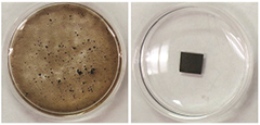A research team led by Northwestern University has solved the solubility mystery of graphene oxide (GO) films using basic inorganic chemistry.
 The image on the left shows the neat GO film, which disintegrated in water. The contaminated film on the right remains stable.
The image on the left shows the neat GO film, which disintegrated in water. The contaminated film on the right remains stable.
According to Jiaxing Huang, who serves as an associate professor of materials science and engineering at the McCormick School of Engineering, the solubility factor of GO films has puzzled scientists for many years and they could not decipher why these films have excellent stability in water. When individual GO sheets are submerged, they would become negatively charged and then repel each other. This phenomenon should cause the membrane to break up, however previous studies have shown that instead of breaking up, the GO films actually become stable.
A product of graphite oxidation, GO is generally utilized to make graphene, a wonder material with a thin sheet of carbon. This material is strong yet lightweight and has immense potential in energy storage and electronics applications. However, over the past three years or so, GO has attracted significant interests due to its possibilities in molecular separation applications.
Huang studied the GO material for a number of years and found that GO’s stability was due to the inadvertent introduction of a common impurity. In order to make a GO film, scientists generally pass the acidic dispersion of sheets via porous anodized aluminum oxide filter discs. Such filter discs are often utilized to prepare membranes of various nanomaterials.
Huang’s research team discovered that at the time of filtration, the aluminum oxide filter discs rust in acidic water to produce a large number of aluminum ions, Al3+. Following this, coupling is observed between positively-charged ion and negatively-charged GO sheets which ultimately stabilizes the ensuing membranes. Other multivalent metal ions like manganese can also crosslink the sheets.
The study also shows that the GO film is not as strong as it was believed before. It were aluminum ions that make the film stronger. This means, GO films are significantly weaker without the presence of ions.
The study has appeared in “On the origin of stability of graphene-oxide membranes in water” published in Nature Chemistry. The Office of Naval Research and the National Science Foundation have funded different parts of the research illustrated in the paper.
We have solved the puzzle using essentially freshman-level inorganic chemistry. Now we know that graphene oxide films are indeed soluble in water. It’s just a matter of sample purity. This is a wake-up call for anyone using aluminum oxide filter discs. People have used it for sample preparation in many areas of materials science and biology. Now we know it’s not as clean as we think.
Jiaxing Huang
References